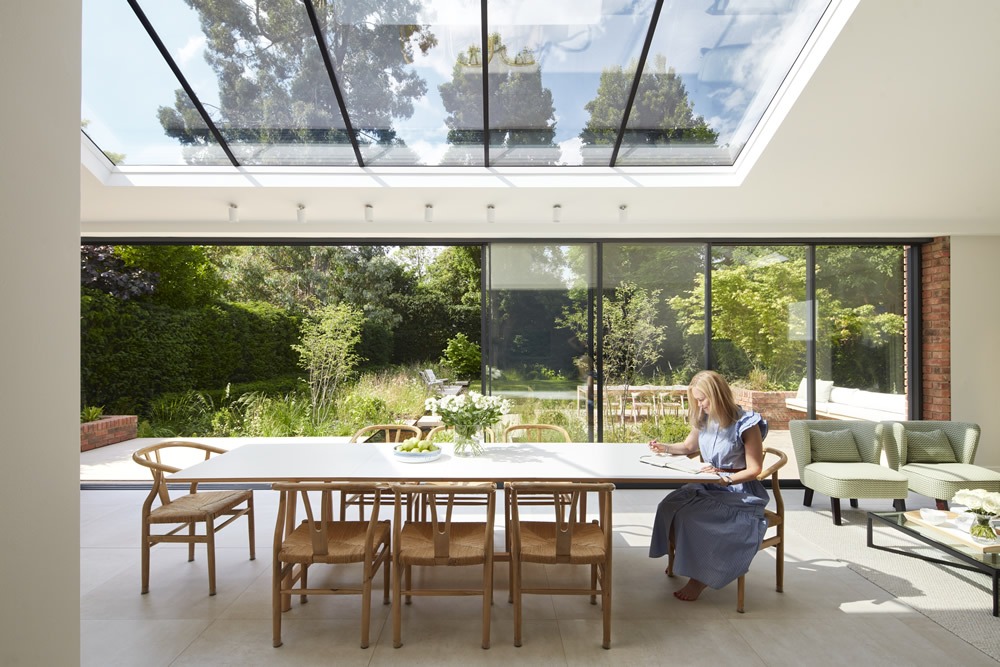Architects often envisage expansive roof glazing to harness natural daylight creatively in grand designs. While bespoke rooflights can give life to these visions, translating glazing plans from drawings to reality involves crucial considerations, especially with the increasing trend towards larger rooflights exceeding 2500mm in width or height.
Weight and Transportation Challenges
As rooflight sizes grow, the thickness of the glass increases, resulting in a significant rise in weight. For perspective, a double-glazed unit with 4mm thick glass weighs 20kg per square meter, while a triple-glazed unit can weigh up to 45kg. When metal frames and liners are factored in, even a modest-sized conservation rooflight can weigh as much as 200kg or more. The complexity escalates with size, and architects need to consider weight implications early in the planning stage. Welding eyelets to aid lifting becomes essential, especially for frames exceeding 100kg, where crane assistance might be necessary.
Manual vs Electric Operation
The weight of an opening rooflight determines whether it’s manually operated or requires electric actuation. While manually operated rooflights are feasible up to certain sizes, larger options, especially those exceeding 1000mm in width or 1400mm in height, may necessitate electric actuation for effective operation and a tight seal.
Architects should consider cost implications when specifying larger opening rooflights, keeping in mind that a single glass piece exceeding 5m² becomes significantly more expensive.
Alternatives to Large Panes
Fortunately, alternatives exist to using large, expensive single panes of glazing. Introducing glazing bars, linking frames, or having more than one casement can not only make rooflights easier to transport, lift, and install but also reduce costs.

Safety Considerations
Ensuring the safety of large areas of glazing, especially situated high in a roof structure, is paramount. Regardless of size, rooflights should meet the BS 5516-2:2004 standard for sloping glazing, defining requirements for laminated inner panes, especially when situated more than 5 meters above floor level.
Collaboration between the architect, structural engineer, and rooflight manufacturer is essential in discussing large rooflight installations, weights, load bearings, site access, and lifting capacity at an early stage to prevent issues later on.
Laminated Glass
While laminated glass enhances safety, it introduces unique challenges such as thermal fracture and heat stress. Polishing edges can reduce the risk, but this is not practical for low-emissivity (low-e) coatings. Swapping low-e coatings for treated edges may impact thermal performance. The use of solar-reflective and thermal coatings like SGG Cool-Lite on the outer pane can help, but these coatings lack a self-clean feature, a vital consideration for pitched rooflights typically positioned out of reach.
Thermal Stress Fractures
Assessing thermal risk involves considering various factors like glass type, building location, orientation of the rooflight, glazing bars, internal shading, framing material, powder coat colour, window size, presence of radiators below the rooflight, and external elements casting shadows. The risk of thermal cracking and heat stress varies throughout the year, peaking in spring and autumn due to the low angle of the sun and lower evening temperatures.
Conclusion
While the trend for more and larger rooflights in projects is growing, specifying them is not as simple as adding them to plans. Architects must understand the complexities involved in large conservation rooflights and collaborate with qualified structural engineers early in the process. This approach ensures a smoother execution of ambitious rooflight designs, considering weight, safety, and installation challenges.

